It’s December 1927. You stand on a cold street outside a house on Fitzroy Square, near London’s thriving West End. You take the stairs down to the basement flat, where a red light greets you, letting you know that you are welcome. You tentatively approach the front door, which is flung open by your acquaintance Bobby dressed in his flamboyant, flowing, gold-trimmed skirt. He smiles widely and takes your hand, pulling you inside, saying, ‘You’ve come along just in time’. The gramophone blares in the background and raucous laughter can be heard; you are excited for the evening ahead.
You are risking everything by being here. But despite it all this is somewhere you know you can be yourself. You breathe a slow sigh of relief and let yourself be dragged into the warmth and the chatter.
A scene like this is what would have greeted several men gathering in Bobby’s flat in the winter of 1927. We know about these gatherings due to the extensive undercover surveillance and surviving records held at The National Archives[ref]A huge debt of gratitude goes to Matt Houlbrook, whose wonderful work Queer London first made me aware of these records and many others relating to queer culture in this period.[/ref]. Why were these individuals being observed? Because at these gatherings men would have relationships with other men, in an era when sexual acts between men were both criminalised and widely socially unacceptable.
In this blog post, I will share the story of the individuals who visited this flat, who defied the law, to boldly live, love and party despite the potential consequences.
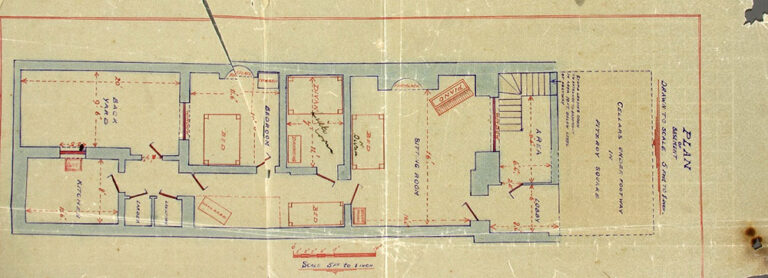
The parties
Hosting these entertaining gatherings, and living at this flat, were Bobby and Constance[ref]This blog post is based predominantly on the Central Criminal Court depositions in CRIM 1/387.[/ref]. Bobby was a dancer on the stage, at this time featuring in the West End hit show ‘Lady Be Good’. Constance was a French national, who seems to have owned the flat; at times it was a convenient cover for them to pretend to be married, with Constance using Bobby’s surname. The attendees at these parties tended to be working class men, with professions including clerks and dancers. Bobby’s family were listed in the 1911 census as a handy man, cigarette maker and dressmaker[ref]At this time Bobby himself was only 11 and still in school.[/ref].
At their Fitzroy Square flat the pair invited friends, and friends of friends, to private performances of Bobby’s dances. On at least one occasion the dance was a ‘Salome’ dance, likely a version of the seductive Dance of the Seven Veils. Salome had its own controversial connotations in this era due to the Wilde trials and a sensational libel trial about lesbians in 1918. It was not an ideal thing to be associated with.
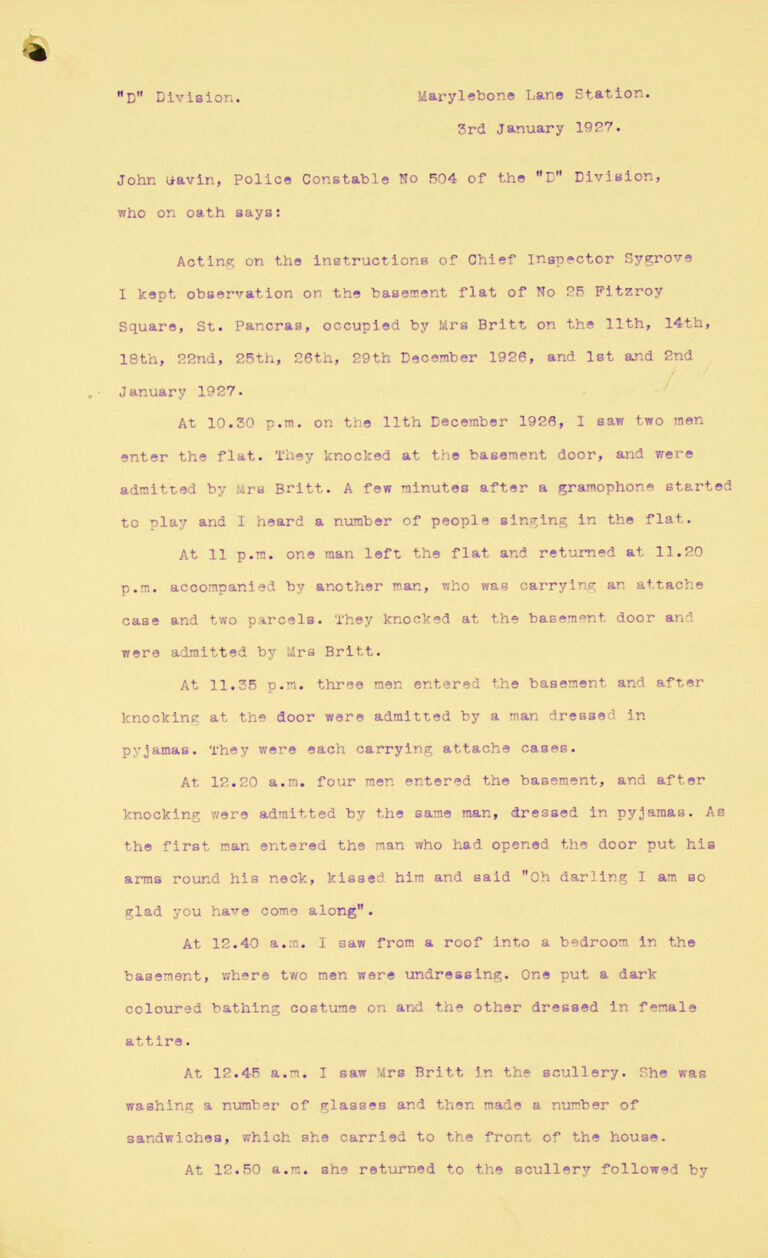
Inside the flat, the individuals were observed to be dancing, singing, kissing and cuddling, and sometimes naked. The gramophone would keep them entertained for hours or sometimes someone would hop on the piano. Most of these observations came from the street outside or from the basement roof, from which a watch was kept. The guests knew they were in a vulnerable position, suggesting that they should enter the flat in pairs, not in a bigger group, and keeping the curtains drawn. On one occasion the bedroom curtains were slightly open, and police were able to look through; an individual inside commented ‘oh look. The window’s open’ and hurriedly shut it, drawing the curtains. Unfortunately, the police had seen enough – two men standing naked.
Photographic evidence
Incredible photographs give us an insight to the dress of the individuals and the inside of the flat; these photographs survive because they were used as police evidence. The interior is striking in its bohemian and ‘oriental’ style; other spaces in this era were similarly fashioned, such as the queer friendly Caravan Club on Endell Street. A red light was fixed outside the front door, while an Eastern-inspired lamp and red walls adorned the bedroom. The bed was intentionally described in police files as a ‘divan’, making it sound more exotic. Dominic Janes notes that at this time the Far East (also linked with the colour red) was associated with effeminacy, sensuality and decadence[ref]Janes, Dominic (2015) The scene of the crime: police photographs, visual culture and sexuality. Legal Information Management, 15 (1). p. 17.[/ref]. Ultimately, this was all useful in building a case against the individuals who partied at Fitzroy Square.
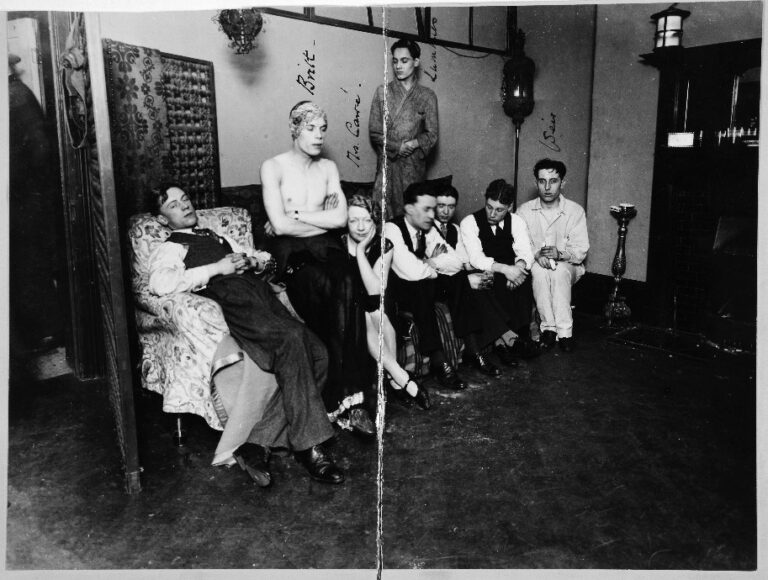
A photograph of the bedroom shows the divan looking recently used, with the sheets ruffled, and a pair of shoes by the bedside, giving the impression of having just been removed. Janes notes, ‘All this together was read by police as indicative of its deliberate design as a place evocative of and conducive to sexual transgression.’[ref] Janes, The scene of the crime. p. 17.[/ref]
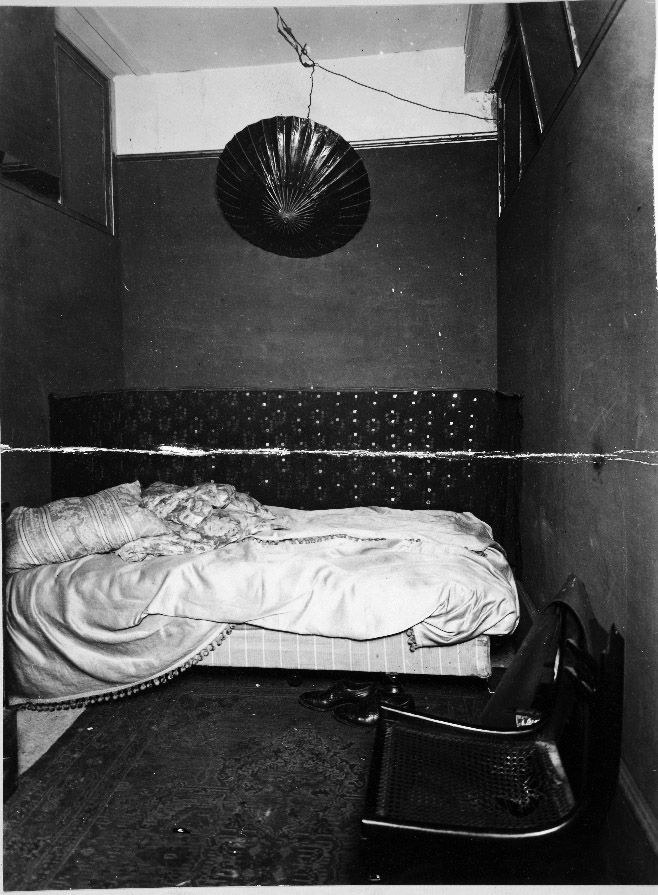
The photographs also show Bobby and his friends, some disobediently looking away from the camera, others appearing indifferent. Their clothes would have also seemed transgressive – Constance wearing a flapper-style dress, with her hair in a bob; Bert in a dressing gown, with a modern-looking swimsuit underneath; Harold wearing a pyjama-style linen suit. Meanwhile Bobby was in his gender-fluid transparent skirt with gilt edges, naked torso, ‘lady’s shoes’ and a patterned headband. The photographs were also annotated by police.
Police observations
The Police had gathered evidence over time, noting men naked in the flat, two men fondling ‘pulling one another about’ in a public telephone box after leaving one night, and Bobby had been observed around his work too, illustrating the extent of the observations. Bobby had been followed from the stage entrance of the Empire Theatre to local urinals around Cambridge Circus. Police observations noted ‘He is generally powdered and painted and smelt strongly of perfume. His eyebrows and eyelashes are also painted as a rule’.
Police paid particular attention to anything perceived to be sexual or related to unconventional gender expression, such as Bobby’s controversial outfit. On one occasion the police observed five men as they approached the front door: ‘Hello girls come on in we are having a right royal time’. One commentator in court remarked that these men ‘behaved as though they were women’, often wearing theatrical costume, being noted as speaking in effeminate voices and would be ‘powdered and painted’. The attendee Alexander was accused by police of wearing make-up, something he took time to directly deny in his police statement, hinting at the damage such allegations could do. Effeminacy, including the use of make-up, was heavily associated with homosexuality at this time. It seems to have been a way of men signalling their sexuality to other men, but it could also be read as such by the authorities.
The raid
After extensive observations over a number of days the basement was finally raided by police on 16 January 1927. Interestingly, this seems to have been a rare occasion of a flat being raided, rather than a commercial venue, such as a club or a bar. Matt Houlbrook talks about the blurred boundaries between private and public spaces that spaces such as this presented; they united a ‘loosely connected network of friends, acquaintances, and strangers’[ref]Houlbrook, Matt, Queer London, Perils and Pleasures in the Sexual Metropolis, 1918-1957. 2006. p. 133.[/ref].
On the night of the raid attendees were questioned by police. Alexander explained:
‘Bobby is my friend. I often come here to a party. We all dance together. It is just a party [by] the boys. I was at the Adelphi rooms when the raid took place.’ [CRIM 1/387]
This demonstrates the nature of queer spaces in this era. Fitzroy Square was just one of several places working class men could meet other men, and yet all these spaces were vulnerable to being intercepted by police[ref]See Matt Houlbrook, Queer London for many more examples, including detail on the Adelphi rooms or see other National Archives blogs.[/ref]. Alternatively, another attendee when questioned said it was his first time visiting, and he had thought it a party, but actually it was a ‘queer show’. He did not approve.
In the courtroom
The court case took place at the high profile Central Criminal Court, on 8 February 1927. The individuals present were accused of:
‘tippling, whoring, using obscene language, indecently exposing their private naked parts and behaving in a lewd obscene and disorderly and riotous manner.’ [CRIM 1/387]
All the defendants pleaded not guilty.
The court was presented with extensive evidence from the detailed observations, as well as a selection of unique objects. These objects were designed to demonstrate the ‘lewd and obscene’ nature of the goings on at Fitzroy Square, and many were perceived to be visual signifiers of homosexuality. These items included a black transparent skirt, red sash, pair of ladies shoes, bathing costume, a pair of slippers, suit of pyjamas, set of photographs, floor plan and letters. Only a select number of these items survive, including the letters and photographs. In court one of the photographs was shown to Mr Justice Avory, who remarked of Bobby, ‘Is he a man?’[ref]’Photographs Taken By Police. Men’s Fancy Costumes In Flat Incident’ article in Reynolds’s Newspaper, Sunday 27 March 1927. British Newspaper Archive.[/ref].
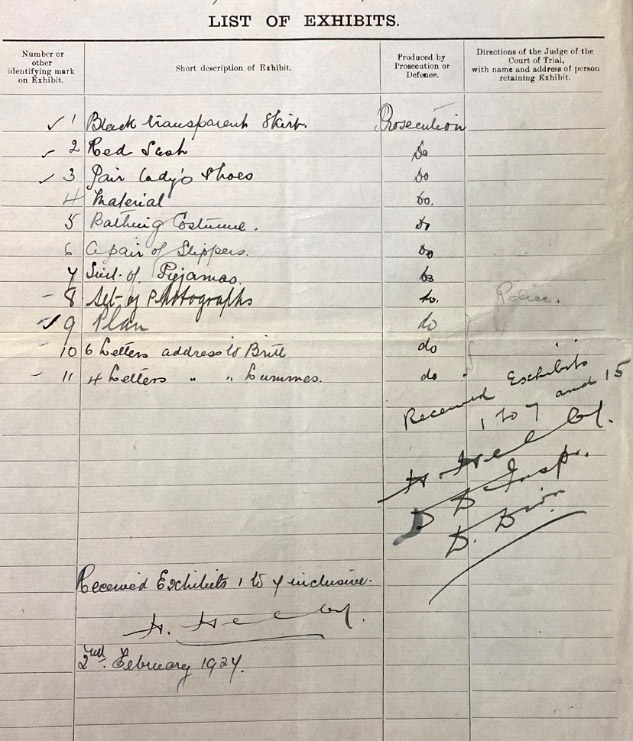
A significant amount of the discussions in court focus on the definition of a disorderly house[ref]’In English criminal law a disorderly house is a house in which the conduct of its inhabitants is such as to become a public nuisance, or outrages public decency, or tends to corrupt or deprave, or injures the public interest.’ Disorderly house – Wikipedia[/ref]. Could this apply to what was essentially a private dwelling? Could a house where men had sex with other men (rather than women) be deemed a disorderly house? After an extensive debate it was decided it could be.
Bobby was charged with keeping a disorderly house, and received the most serious sentence of 15 months hard labour. Alexander and Bert received shorter sentences in the second division.
After 1927
We know little about these individuals after this snapshot in time; after all, they were not famous, just working class men who dared to love and live their sexual lives fully. The 1939 Register does show Bobby listed as ‘single’ and living in Paddington. Further records suggest that Bobby lived to the age of 100. He had been born in 1900 and would have lived through many changes in the law. For a significant period of Bobby’s life, the 1967 Sexual Offences Act would have been in force, decriminalising homosexual acts in private. He also remained a professional dancer[ref]The Tale of Bobby Britt and ‘Prudes on the Prowl’ at the Empire Theatre, Rob Baker January 16, 2018[/ref].
Find out more about the love letters found in Fitzroy Square in my next blog post.
I am very fond of Fitzroy square and make a point of visiting it when I am in London. This story of Bobby and friends added colour to the history of this beautiful square . I look forward to more revelations.
I found this to be a very interesting and thought provoking article highlighting LGBT and the stigma associated all those years ago.
Thank goodness times have changed for the better.
Well done National Archives.
Very interesting that Bobby Britt was the uncle of Bert Lummes who is the figure standing high up in the sitting room photo. Bert was born in 1909 so was only about 16 or 17 when the party occurred. Bert’s mother was Jane Lilian Britt who was Bobby’s sister, 11 years older. After their prison sentences they both travelled to New York in 1929 with a show – the ship’s list shows them both as actors. And their previous addresses were nearly adjacent flats in the same road in Stockwell. Maybe Bobby acted as a sort of mentor/older brother role for his young gay nephew.